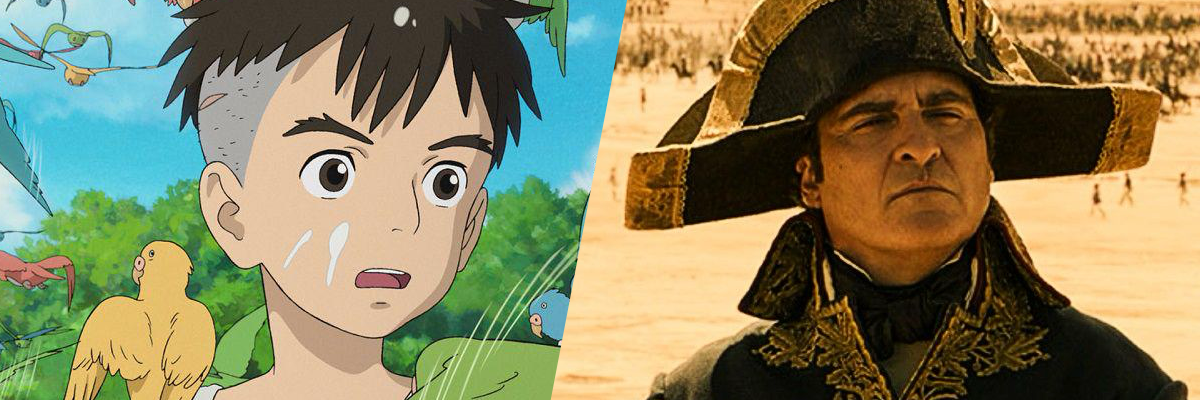A pair of big screen spectacles by octogenarian directors that I’m pleased to have been able to see on the big screen.
THE BOY & THE HERON marks Hayao Miyazaki’s first theatrical directorial effort in a decade, and blends fairy tale whimsy with loose autobiography; Miyazaki did not lose his mother at a young age, as protagonist Mahito does, but his father WAS a director for an airplane parts manufacturer, and they DID evacuate Tokyo in the wake of U.S. air raids. Mahito and his father have evacuated to the late mother’s sister’s estate; she’s having his second child, and Mahito is frustrated and angry that this woman is suddenly in his life seemingly trying to replace the mother whose death he’s, quite understandably, not over yet. As he’s working through these feelings, a grey heron keeps appearing and harassing him, trying to lead him to a strange tower in the woods. And that’s all I’ll say — more than I knew going in, and a LOT more than the original Japanese audience did; there were no trailers, and even the original title is more vague (“How Do You Live?” after a 1937 novel that appears in a key moment of the film). A bit meandering, but full of interesting sights to behold and moments of pure hand-drawn wonder — though honestly, the opening scene depicting the hospital fire that takes Mahito’s mother’s life is perhaps the most memorably technically astonishing sequence. I doubt this will be anyone’s favorite Miyazaki film (mine remains PORCO ROSSO), but I think it’s absolutely worth seeing what anime’s grumpy workaholic granddad came out of retirement to make — it definitely plays to me like the work of someone who just couldn’t get a handful of ideas out of his head and needed to sculpt them into this one big thing to share them with the world.
Speaking of workaholics, but one who clearly has NO intentions of retiring anytime soon, Ridley Scott’s NAPOLEON is a wildly entertaining historical epic, following the rise of its title character from young army officer, to coup plotter, to Emperor, and ultimately to his exile, attempted return, and exile again. Joaquin Phoenix plays an absurd Napoleon, awkward with a strange shuffling gait, but also boastful and assured, and capable of employing great charisma to get what he wants. Vanessa Kirby, who I know best from the last two MISSION: IMPOSSIBLE films, is Josephine, the love of his life, who he nevertheless divorces when it is determined she will never bear him an heir; the push & pull of their relationship, his obsession and her fondness, is the heart and true throughline of the film — oh sure, historical accuracy has been thrown out the window to better anchor the film there, but I think it does make for a better movie. Kirby’s Josephine is sharp, teasing, and convincingly someone who could have one of the most powerful men in the world wrapped around her finger. So much of the rest of the film, outside Josephine’s orbit, is made up of huge, spectacular battles, well worth seeing on the biggest screen you can — bloody, full of cannon fire, cavalry, and men beating each other to death in mud. It’s over two and a half hours long, but the only time it dragged for me was the very end — and I don’t think that’s the movie’s fault, I just know full well where Napoleon’s final military loss was, so the minute that name was invoked I knew where the movie was headed, and it still took something like twenty more minutes to get there. I am curious about Scott’s longer cut that’s ultimately going to be on Apple TV+, how that’ll rearrange the focus and what’ll be better developed — and what might have been wholly left on the cutting room floor here, given that this does feel quite complete on its own. Good fun if you’re not too bothered by the way Scott and writer David Scarpa have twisted history for the sake of a better yarn; I’d say it’s worth seeing for the scale of it and for Phoenix’s barmy performance.
